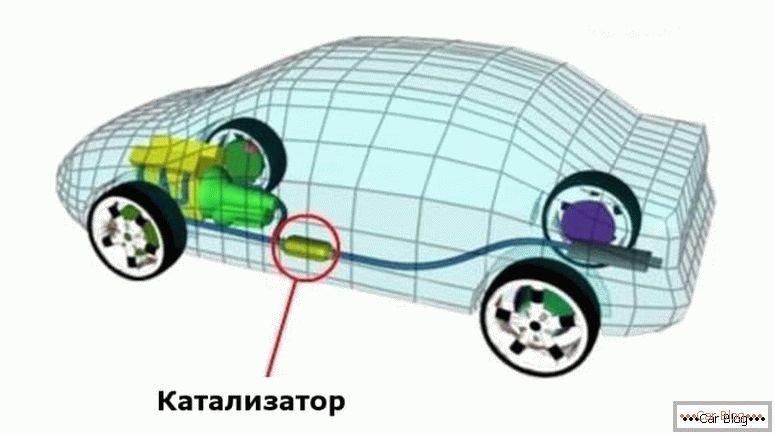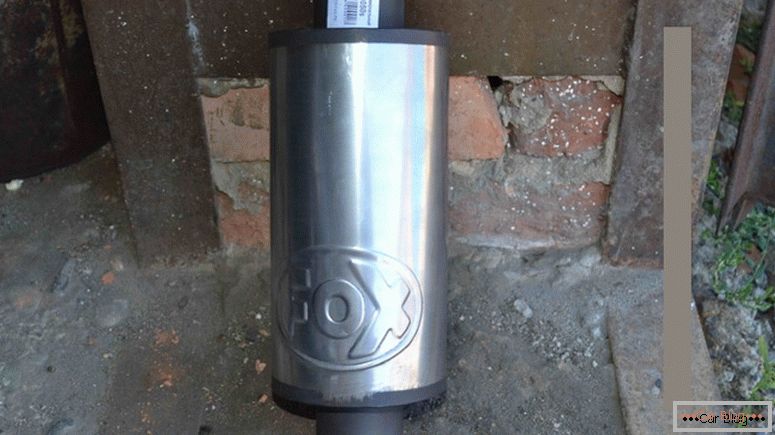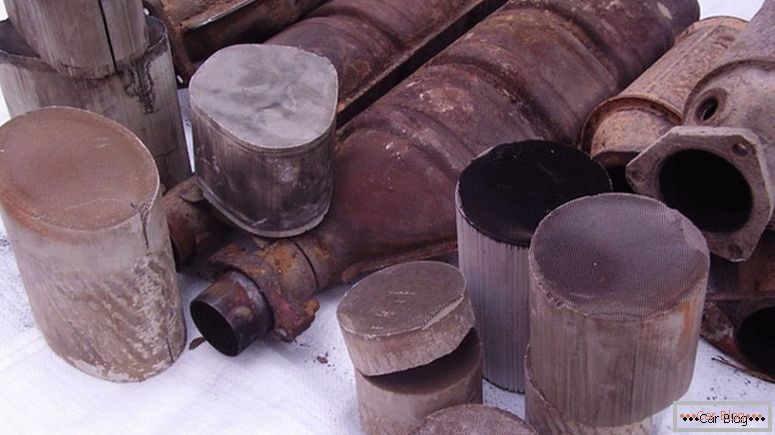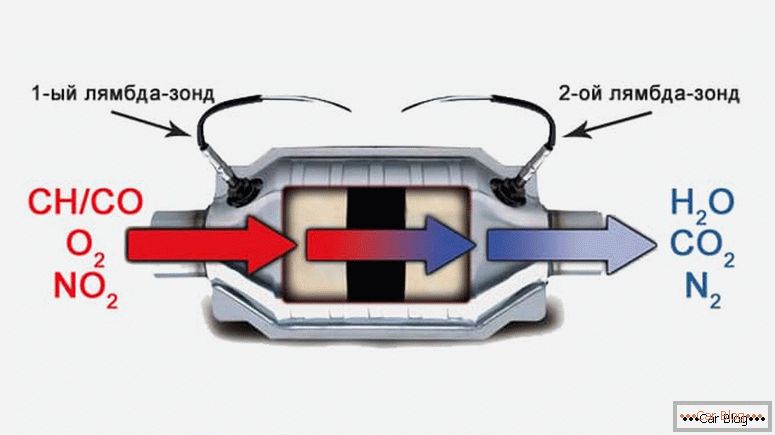Большинство автовладельцев интересуются вопросом, что такое автомобильный катализатор и какую функцию он выполняет только после обнаружения неисправности этой детали. В предложенной статье мы постараемся доступным языком рассказать, why do you need a catalyst in the car, почему у него большая стоимость и что делать, если механизм вышел из строя.
Content
- 1 Principle of operation of the catalyst
- 2 Causes of catalyst failure
- 3 How to deal with a faulty catalyst
- 4 How does the engine without catalyst
Principle of operation of the catalyst

Approximate location of the catalyst in the car
The catalytic converter (catalyst) is an integral part of the exhaust system, which is responsible for reducing the concentration of harmful substances in the exhaust gases. These are CH (hydrocarbons), NO2 and NO (nitrogen oxides), CO (carbon monoxide). They are poisonous and are part of the smog. The task of the catalyst is to first heat up from the exhaust gases, and then afterburn harmful substances and bring the exhaust to the established environmental standards. Inside the device is a metal or ceramic structure in the form of honeycombs. A layer of a special platinum-iridium alloy is applied on top of it. Cellular design is necessary to increase the contact area of the exhaust gases with the plane, which has a catalytic layer. Oxidation of CH and CO takes place, and as a result, harmless N2 and CO2 are obtained.
Causes of catalyst failure
During normal operation, the device most often begins to malfunction as a result of the combustion of the catalytic layer. The decrease in the area of this layer contributes to the fact that the catalyst no longer qualitatively burns exhaust and the level of emission of harmful substances begins to increase. When the value becomes greater than the value set in the control unit, the CHECK ENGINE light on the dashboard will light up. When diagnosing, it will be possible to see that the error stored in the ECU means “inefficient operation of the catalyst”. The resource of the device is approximately calculated for 100 000 km. Data on the state of the exhaust gases produces a special sensor lambda probe, which is located behind the catalyst.

Often, a flame arrester is installed in place of a faulty catalyst.
Malfunctions in the mixture formation system and the ignition system can also affect the premature failure of the catalyst. In this case, the cells are clogged, which does not allow the device to fully oxidize the mixture. Also, the cause of a malfunction may be low-quality gasoline. This fuel contains a large amount of tetraethyl lead, which is added to artificially increase the octane number. It turns out that part of the catalytic layer is closed with tetraethyl lead, which violates the proper operation of the device.
See also: How does a gasoline internal combustion engineHow to deal with a faulty catalyst
The catalyst is not repairable and must be replaced. Dealers very often refuse to perform a replacement under warranty. They motivate it by the fact that the device has failed due to the use of low-quality gasoline, and suggest installing a new part. The cost of the original catalyst is 35-150 thousand rubles. Even a full warranty on the device, no one provides. Why is the catalyst so expensive? It should be understood that this device on modern cars is a complex part, which consists of flange connections, exhaust manifold and tank. Of course, such a mechanism is expensive and quite complicated to manufacture. Also in the catalysts there are precious metals, and they themselves are very expensive. Taking into account the special conditions of customs clearance, and the result is an extremely high price. Specialized automotive workshops offer several alternative options for catalyst failure:

Defective catalyst cannot be repaired, it is simply thrown away.
- Installation of a universal catalyst. Such a device is the catalyst barrel itself. It is welded to the exhaust system instead of a faulty catalyst. Replace the failed part, and not the whole tube. This is a more correct and profitable option, which will cost from 10 to 16 thousand rubles, depending on the required size and characteristics.
- Installation of flame arrester. In this case, the catalyst is completely dismantled from the system. Instead, set the preliminary resonator (flame arrester). However, it does not purify the exhaust gases. The device stabilizes the exhaust flow and removes unwanted extraneous sounds.
- There is another extremely cheap, but not environmentally friendly option - to put a snag lambda probe. It can be either a spacer that separates the sensor from the exhaust gases, or a small circuit from a capacitor and a resistor. This scheme distorts the readings from the oxygen sensor in such a way that the control unit sees a perfectly clean exhaust, while you can do anything with the catalyst itself, it may not even exist at all.
How does the engine without catalyst
Lambda probe (oxygen sensor) is necessary to determine the oxygen concentration in the exhaust gases. Efficient operation of the internal combustion engine is ensured by maintaining a stable ratio of fuel and air in the system. This is possible through the use of an oxygen sensor that is in the release. The process of controlling the oxygen content in the exhaust is called lambda regulation. Often two sensors are installed: in front of the neutralizer and behind it. The sensor installed in front of the catalyst sets the optimal ratio of fuel and air for efficient engine operation.

Catalyst system with two lambda sensors
Among motorists there is a perception that a sensor installed after the catalyst is needed only to determine the malfunction of the catalyst. This is true, but what will happen if you remove the catalyst, and how will the control unit respond? Imagine the situation that the catalyst had to be dismantled. In this case, the second sensor detects a malfunction and automatically begins to reduce the temperature in the combustion chamber. The system can perform such an operation only by adding fuel. As a result, the mixture turns out to be enriched, the engine power is reduced, and fuel consumption increases. In other words, the control unit starts to work in some emergency mode and prepare the appropriate average mixture, if only the engine is working, not trying to set the optimal mode of fuel supply.
It is possible to prevent excessive fuel consumption by returning the engine from emergency mode to a normal state. A defective catalyst should be replaced and reprogrammed the electronic control unit in EURO2 mode. Well, or as already mentioned, you can put a special snag on the second oxygen sensor.



